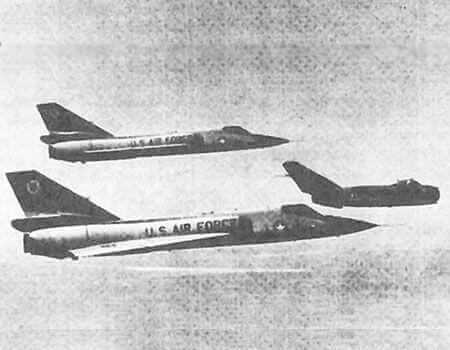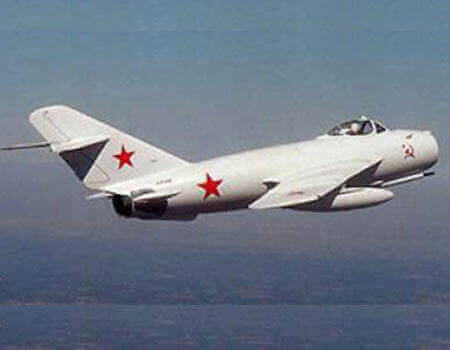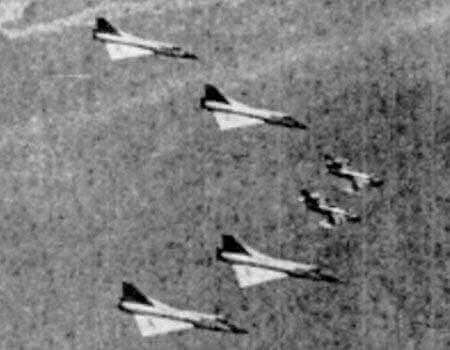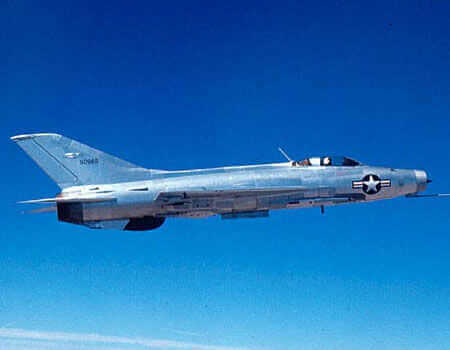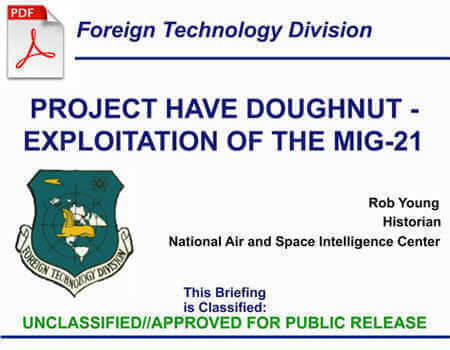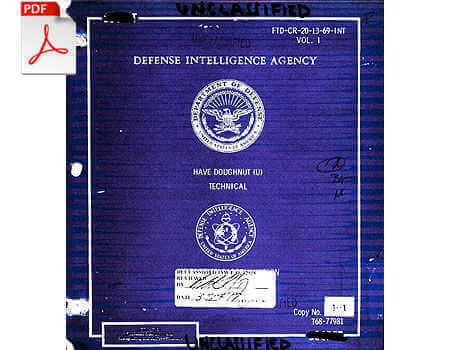ADC comments on Project HAVE DOUGHNUT
ADC found visual contact difficult because of small size, except the silver color made the planform view relatively easy to see. The radar signature to the MA-1 fire control system indicated contact and tracking adequate for Intercept completion with contact 20–25 miles in all aspects. ADC found stern contacts the best and head-on co-altitude the worst. Regarding an F-4, it provided a return l/2 as large in front, 3/4 in beam and almost identical in stern because of engine modulation. The IR signature to the MA-1 fire control system proved adequate for acquisition and tracking. ADC found it about 3/4 as strong a return as the F-4 and similar to the F- 106 in military, however, not as strong as F-106 in A/B afterburner. ADC found the performance of the test aircraft not as good as expected. Limiting factors making it capable of exploitation included slow engine response in military required for A/B initiation, q limit below 15,000-feet, visibility to rear, and visibility over the nose. Another area needing exploiting included energy and time required to transit the transonic zone with pylons and missiles aboard. Its controls stiffened at low speed and low altitude. It lacked endurance at maximum power, and had only one radar fire control system. ADC found the F-106 aircraft’s radar capable of acquisition and usable to put the F-106 in position for armament launch. The F-106 used radar snap-up attacks with all-aspect armament load to exploit test the MiG-21’s lack of adequate fire control system. The F-106 took advantage of the inability of the MiG pilot to see over the nose and through the windscreen. The ADC recommended using the F-106’s ability to accelerate faster than the MiG-21, enabling it to achieve a higher speed (beyond q limit) to separate anytime it found the F-106 not in an advantageous position during engagements. The F-106 could use missile launch and then use lag pursuit while closing to gun kill position, depending upon its superior turn capability to pull necessary lead for gun firing.
ADC recommended expediting procurement of cannon for F-106 for near term close-in-kill armament, and use the superior zoom capability of the F-106 to advantage for repositioning after separation during engagements.
The ADC cautioned the bar overhead in the F-106 canopy causing F-106 aircrews to lose sight of the MiG-21 during close-in engagements. With this defect, roiling maneuvers could get the F-106 into trouble and every effort made to expedite replacement of the F-106 canopy bar with a clear pane. Following the exploitation, ADC cautioned F-106 aircrews to take care to preclude unnecessary expenditure of energy when observing the MiG-21 initiating a turn. The appearance of generation of a great amount of turn was deceiving.
The misleading size of the MiG-21 caused error in estimation of range and rate of closure by F- 106 aircrews. Thus the F-106 should not attempt slow speed turning contests with the MiG-21 as performance was close to equal and a slight miscalculation could be fatal. The F-106 should keep its speed at 400 to 450 KCAS during patrol and during an engagement. The exploitation determined the F-106 could use its missile armament during an engagement with efforts to modify the fire control system with IE “boresight expedited. The IR “boresight modification should include an automatic radar look-on by caging the radar antenna to the IR head. It should sweep the range gate out to affect radar look-on with the option of caging the radar antenna dead ahead.
The ADC exploitation of the MiG-21 found the F-106 patrol formation, as taught at the Interceptor Weapons School, provided adequate protection against surprise attack by the test aircraft. It recommended improving F-106 radar and all flight members know visual search patterns to insure responsibilities for sector search.
The evaluation determined radar tracking procedures lacking and the need for procedures for assigning responsibility within and between elements for armament launch when some or all members of the flight acquire a MiG-21. The F-106 aircrews needed training that when pressing an attack after acquiring the test aircraft, they expended armament in order of priority, i.e., missiles, then press to gun position or separate if no gun is aboard or all missiles are expended.
The ADC found an all-aspect armament capability with a successful qualification of 5 out of 5 missile simulator evaluators (WSEMS) during the test. This indicated that properly prepared AIM-4F missiles will see the test aircraft as far out as 3.5 miles on front aspects with a high probability of successful guidance. The F-106, with its present configuration and with developing tactics, proved capable as an effective counter to the MiG-21.
The two MiG-17s flew 198 sorties (usually together) against a variety of US Navy warplanes, ranging from the F-8J Crusader to the A-6A Intruder. Later, separately, they flew against the USAF F- 102A Delta Dagger, F-104A Starfighter, and F-106A Delta Dart.
The Aerospace Defense Command and US Navy attack and fighter squadrons under the overall management of the FTD conducted both technical and tactical evaluations of the Fresco C. The evaluations occurred under simulated combat conditions against the F-4, F-5, F-8, F-100, F-102, F-104, F-105, F-106, A-4, A-6, and A-7 aircraft.
The MiG-17 (NATO code name Fresco) was the first Soviet fighter to have an afterburning engine, the Klimov VK-1. Although similar in appearance to the MiG-15, the MiG-17 has more sharply swept wings, an afterburner, better speed and handling characteristics and is about three feet longer. The wings of the aircraft are mid-mounted, swept-back, and tapered with blunt tips. They have wide wing roots. The engine is one turbojet inside the body and has a round air intake in the nose. It has a single, small exhaust. The fuselage is short, thick, cigar-shaped and tapered to the rear. It has a blunt nose and bubble canopy. The tail fin is swept-back and tapered with rounded tip. Flats are high-mounted on the tail fin, swept-back, and tapered. Flats and fin overhang the exhaust. The MiG-17PFU was armed with four AA-1 "Alkali" radar-guided missiles, making it the Soviet Union's first missile armed interceptor.
The MiG-21 Fishbed is the most built jet ever. Fast, small, agile dependable, and above all simple, this swept-wing MiG design called "Faceplate" by NATO was turned out in prodigious numbers, flooding the skies above Europe, Asia, Africa, and even Central America with literally thousands of modern, deadly fighters. It has flown in more wars than any other airplane in the world, over 10,000 of them produced by the Soviet Union, it's allies and China with a 30-year record equal, and parallel, to the McDonnell Douglas F-4 Phantom II.
The MiG-21 prowess isn't its target capabilities or range. Known as a pilot's plane partially because it doesn't have any computers or fancy navigation equipment, the swept-wing Fishbed depended on the pilot's training and experience. Though this lack of technology might be termed the MiG-21's Achilles verse, it certainly shocked the Phantom pilots when it arrived in the skies over Vietnam and proved itself over and over as a formidable dogfighter against the heavier American fighters, which was another reason for the success of the MiG-21. An analog to the F-104 in that it is a Mach-2 fighter, its reliable engine, easy maintenance, rough field capabilities, and safe flight characteristic made it the most successful jet aircraft of all times.
The MiG-21F is a short-range day fighter-interceptor and the first major production version of the popular MiG-21 series. It is but one of many versions of this aircraft that have served in the air arms of many nations around the world. The E-5 prototype of the MiG-21 was first flown in 1955 and made its first public appearance during the Soviet Aviation Day display at Moscow's Tushino Airport in June 1956. During the Vietnam War, MiG-21s were often used against U.S. aircraft. Between April 26, 165, and January 8, 1973, USAF F-4s and B-52s downed 68 MiG-21s. More than 30 countries of the world-including nations friendly to the U.S. -have flown the MiG-21. At least 15 versions of the MiG-21 have been produced, some outside the Soviet Union. Estimates place the number built at more than 8,000, a production total exceeding that of any other modern jet aircraft.
The aircraft has mid-mounted delta wings with small square tips. There is one turbojet inside the body. There is a small round air intake in the nose. There is a single exhaust. The fuselage is a long, tubular body with a blunt nose and bubble canopy. There is one belly fin under the rear section. There is a large dorsal spine flush with the canopy. The tail fin swept-back and tapered with a square tip. The flats are mid-mounted on the body, swept-back, and tapered with square tips. The J-7FS modification adds a radar to a reconfigured air intake, while the "Super 7" upgrade would have completely reworked the front end of the aircraft, adding a much larger radar and ventral air inlets, along with various other less pronounced improvements.
MiG-21 aircraft acquired by the United States under the Foreign Materiel Acquisition/Exploitation program are designated as the YF-110.
In the former USSR this aircraft was manufactured between the late 50s and the middle 70s. The MiG-21 is the world champion in the number of the air vehicles produced (11,000) and in airframe service life (up to 30 years). That is why about 3,000 MiG-21 are now operated by the air forces of more than 40 countries. The MiG-21 is close to setting another world record in the amount of the upgraded aircraft.
MiG-21MF is a single-engine, single-seat supersonic jet fighter designed primarily for destruction of air targets by guided and non-guided weaponry and for air reconnaissance. To a certain extent, the aircraft can also be used for destruction of ground targets. A two-seat modification MiG-21UM is designed for advanced and perfection training of pilots for MiG-21 types. MiG-21MF (NATO reporting name Fishbed-J) represents the first third generation interceptor/fighter designed to gain and maintain air superiority. It was developed as a universal type to fulfill fighter tasks and multipurpose fighter/bomber tasks with limited possibilities in adverse weather conditions. It is equipped with the R-13F-300 engine with additional combustion, and the RP-22S radar. This type of MiG-21MF was manufactured in 1974 to 1975. Capacity of the internal fuel tanks is 2650 litres. The aircraft can be equipped with an optional external fuel tank under the fuselage and two tanks under the wings with a total capacity of 1470 litres. As to missiles, it can carry R-13A, R-60 and R-MK short-range air-to-air missiles. Standard equipment is the 23mm GSh-23L gun. MiG-21MF can also be used for air support of ground forces. In such case it can carry UB-16-57 or UB-32A launcher tubes, 240 mm S-24 air-to-surface rockets, or bombs up to 500 kg.
The upgrade project offered by RAC "MiG" and named MiG-21-93 is based on the use of "Kopyo" ("Spear") airborne radar, new weapons and equipment. This project has been developed jointly by RAC "MiG", Phazotron-NIIR Company, GosNIIAS and "Sokol" Joint-Stock Company under the general patronage of "Rosvooruzhenye" company. Due to high technical characteristics and reasonable cost, the project has won the Indian tender for MiG-21 fleet retrofitting. The "Kopyo" radar is designed for controlling the full aircraft weapons spectrum: built-in gun, rockets, advanced missiles with homing heads and guided bombs. This makes it possible to enhance qualitatively the MiG-21 following characteristics:
air target detection and lock-on range both in look-up and look-down with using R-27 and RVV-AE middle-range missiles ( the latter can be launched against several targets simultaneously); ground and sea-surface target detection and improved communication, EW and navigation aids; air target detection and engagement range in action in the front hemisphere; improved guidance and engagement capabilities in action against ground targets of any type; track-while-scan mode with the capability of tracking up to 10 targets and engaging two of them; capability to battle successfully with forth-generation fighters; effective destruction of ground targets covered by enemy air defense. In accordance with the Indian party request, a number of systems of Western and Indian make have been combined in a single avionics complex. The main objective of the MiG-21-93 project is to achieve the maximum combat effectiveness with minimum aircraft changes and extend the service life of this reliable aircraft (up to 40 years and 4,000 flying hours). Also, this rational approach to MiG-21 upgrade allows the Customer to save great funds to the utmost. Essentially the tests of the aircraft have been completed and the series production of the upgraded MiG-21bis aircraft for the Indian Air Force has been launched.
